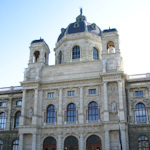
The city’s museums are among the best in the world, displaying many objects of global importance and featuring top international exhibitions. Discover just what’s on offer…from Klimts and Bruegels to the batons of famous composers.
- Book a concert experience* for your visit
- See also:
Jump to museums for…
- Art & design
- Top 3 / Modern & contemporary / Art pre-1900 / Architecture & design / Photography
- History & culture
- Habsburgs / The rest
- Music
- Science, technology & nature
- Entertainment
Art & design museums

(The Kunsthistorisches Museum at night…obviously)
Vienna is a bit of a paradise for art lovers. It’s hard to go a few metres without stumbling into something that would fetch a few million at Sothebys. Like these top artworks, for example.
I have a list of current and future exhibition highlights, but the main art and design museums include…
My top 3 picks
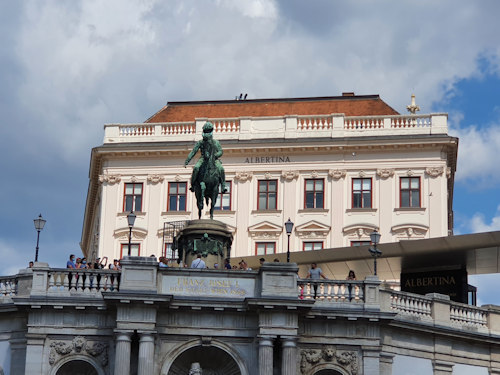
(The Albertina)
I’d select these institutions as the most important for visitors:
The Kunsthistorisches Museum
The KHM museum of art history contains a top-notch paintings collection (Bruegel, Rubens, Raphael etc.), the Kunstkammer chamber of wonders, the coin collection, the Egyptian collection, Greek & Roman antiquities, and special exhibitions.
The Albertina
The Albertina has its own mammoth collection of art (including Albrecht Dürer’s Young Hare) and holds many special exhibitions that stretch from Renaissance etchings to contemporary sculpture. The permanent display covers the likes of Monet, Picasso, Cézanne, Chagall etc.
Belvedere
The Belvedere group has three locations:
- The Upper Palace: special and permanent exhibitions featuring everything from medieval to contemporary art. Contains a world-leading collection of Klimt paintings, including The Kiss
- The Lower Palace: a permanent exhibition of medieval art, as well as special exhibitions that can feature anything from Dürer to Dalí
- Belvedere 21: a clear focus on contemporary art
Modern & contemporary art

(The Bank Austria Kunstforum Wien)
- The Bank Austria Kunstforum Wien: home to a series of high-quality international exhibitions on the more contemporary side of artistic life (think Hockney not Holbein)
- The Heidi Horten Collection: dedicated to showcasing the prestigious modern and contemporary art collection put together by billionaire Heidi Goëss-Horten. Expect lots of top artist names
- The Albertina Modern: focuses entirely (as you might guess from the name) on modern and contemporary art exhibitions
- The MuseumsQuartier or MQ: a centre for contemporary culture with exhibition spaces, cafes, bars, shops, and several on-site museums and institutions, including:
- The Leopold Museum (famous for its Schiele and Klimt collection)
- The MUMOK Museum of Modern Art
- The Kunsthalle with its contemporary art focus (a smaller second location exists on Karlsplatz square)
- The Kunst Haus Wien: contains the Hundertwasser Museum and contemporary art exhibitions with an environmental focus. The building itself is worth a look in its own right, before you even get to the works of art within
- The Wien Museum MUSA: another museum hosting special exhibitions. Usually focuses on themes connected to Vienna, as well as showcasing the work of new artists
- The Ernst Fuchs Museum: located in the restored Otto Wagner Villa and filled with the art, design, decor, and character of the renowned Austrian artist, Ernst Fuchs (1930-2015)
- The Dom Museum: houses many of the treasures of Stephansdom cathedral, but also (unexpectedly) some modern art
Art pre-1900
- The Gemäldegallerie (paintings gallery) of the Academy of Fine Arts Vienna: home to Bosch’s The Last Judgment and other paintings by old masters, but usually presents them in juxtaposition with contemporary works
- The Schottenstift Museum: the abbey’s in-house museum with various secular and ecclesiastical treasures. Has the fabulous 15th-century Schottenaltar panels
Note that many of the museums dealing with history and other topics may also have special art exhibitions running: check the listings calendar for tips.
Design & architecture
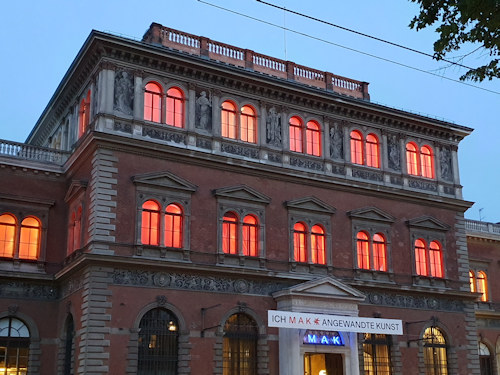
(The MAK museum)
- The MAK Museum of Applied Arts: a lovely museum covering (shock!) applied arts and design through history and all the way to the modern day. Notable for innovative and excellent special exhibitions that often feature contemporary artists
- The Austrian Architecture Museum (no prizes for guessing the theme): located in the MuseumsQuartier
- The Möbelmuseum Wien: the Vienna Furniture Museum filled with, well, furniture (but other items, too) that would make antique experts squeak with joy
- WAGNER:WERK: a small and very specific museum that deals with the history of the postal savings bank and, particularly, the famous building that became its headquarters (a seminal moment in modern architecture)
- The Augarten Porcelain Museum: attached to the company of the same name and displaying a mix of classic and contemporary porcelain pieces
Photography

(Westlicht photography centre)
- FOTO ARSENAL WIEN: a relatively new institution with contemporary photo exhibitions and more
- Westlicht: home to a camera museum and a series of photography exhibitions that includes one around the annual World Press Photo winners
Museums of history & culture
The Habsburgs dominate local history, but the city’s museums also cover those periods before and after the dynasty’s time in Vienna.
The Habsburgs
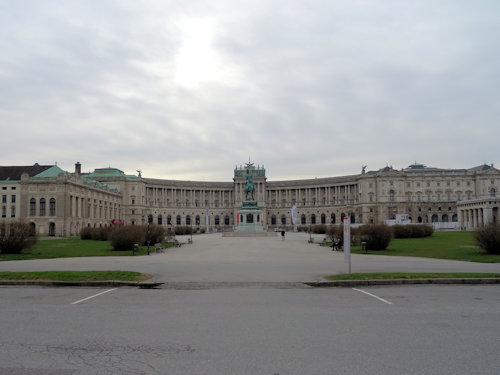
(The Neue Burg houses the Imperial Armoury, for example)
The central Hofburg complex is the former city-centre home of the dynasty. Various bits now house museums and collections. Notably:
- Sisi Museum: covering the life of the enigmatic Empress Elisabeth
- Kaiserappartements: the Imperial apartments occupied by Elisabeth and Emperor Franz Joseph in the late 19th century
- Silberkammer: the Imperial silver collection, which contains a lot of tableware, crockery and similar, whereby you really need more fancy words to describe the kind of pieces within
- The Schatzkammer: the Imperial Treasury with its crown jewels and ecclesiastical relics. As you can imagine, the ruling dynasty put together quite a collection over the centuries
- The Imperial Armoury: a collection of mostly ceremonial and tournament armour and weapons used by the nobility. Housed in a wing of the Weltmuseum (see below)
And elsewhere…
- The Wagenburg: located on the grounds of Schönbrunn Palace and featuring the Imperial carriage collection and an exhibition on Empress Elisabeth
- The Children’s Museum: also found in the Schönbrunn Palace complex. Entertain the little ones with insights into life for the average imperial toddler
- The Hermesvilla: a former summerhouse built for Empress Elisabeth in the 1880s, now fully restored. Tucked away in the wooded surrounds of the Lainzer Tiergarten nature park
Other history & culture
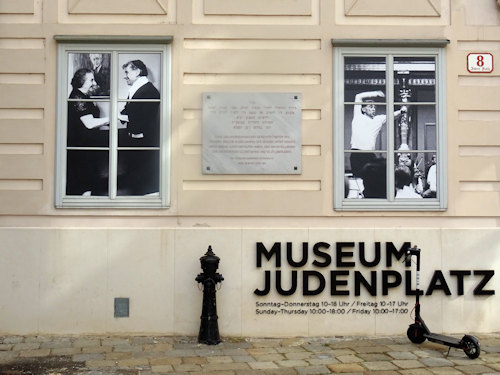
(The Judenplatz site of the Jewish Museum)
- The Wien Museum: manages many of the sites mentioned on this page but also has a huge central building covering Viennese art, history and culture in its entirety
- The Jewish Museum: discover more about the history of the Jewish community in the city. The museum also has wide-ranging special exhibitions
- The Weltmuseum: a modern ethnographic museum you can consider a museum of people and cultures, full of artifacts from around the world. Many exhibitions also draw in contemporary art
- The Volkskundemuseum: the Austrian museum of folk life and folk art, but with a contemporary ethnographic touch
- The Heeresgeschichtliches Museum: technically the Museum of Military History, but really a history museum with a military focus. Among many historic exhibits…the car Franz Ferdinand was in when assassinated in Sarajevo, precipitating World War I
- The House of Austrian History: a museum that covers the country’s more recent, post-Habsburg story
- The Pratermuseum: looks specifically at the history and sociocultural highs and lows of the famous Prater recreational area
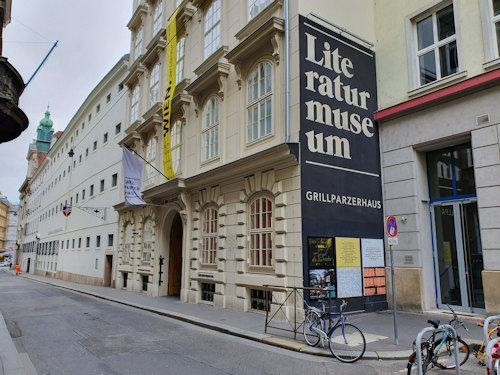
(The Literature Museum)
- The Theatermuseum: housed in the baroque Palais Lobkowitz, where Beethoven often visited. Holds temporary exhibitions related to theatrical history but also features, for example, the Eroica Saal and a work by Klimt
- The Literature Museum: journey through the literary history of Austria. Gorgeous display architecture and also includes the original office of the writer Franz Grillparzer
- The Sigmund Freud Museum: dedicated to the father of psychoanalysis
- The Roman Museum: lovely little institution with excavations and overviews of Vienna’s rich Roman history
- The Ephesos Museum: a small collection of statues, reliefs, and other antiquities from excavations at the Turkish site of what was once a large Greek and Roman city
- The Papyrus Museum: a globally-important collection of papyrus fragments and documents dating back up to 3000 years, as well as other items from ancient Egypt
- The Esperanto Museum: introduces you to the history and importance of the language
- The Third Man museum: quite apart from a huge collection of movie memorabilia that includes some quite exceptional items, it also has a special history exhibition on the years around WWII Vienna
Museums of music
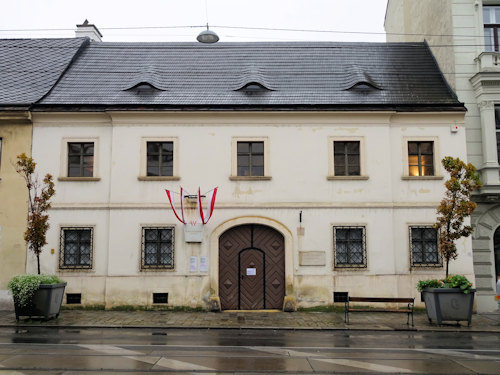
(Schubert’s birthplace)
A vast number of famous composers, musicians, and singers lived in Vienna, so various museums pay appropriate tribute. For example:
- The Mozarthaus: containing the only remaining original home of Mozart and his family, as well as a museum dedicated to his many years in Vienna and the music he wrote in the city
- The Haus der Musik: a museum of sound, the House of Music also has a series of rooms dedicated to various composers with a strong historical connection to Vienna, including Mozart, Beethoven, Haydn, Schubert, Mahler, and Brahms.
- The Beethoven Museum: covering his life, works, music, and legacy. Located in the very house where he (probably) wrote his Heiligenstädter Testament
- The House of Strauss: refurbished palais with a modern interactive exhibition on the Strauss dynasty as a whole, a restaurant, and regular concerts
- The Historical Instrument Collection takes you through the development of instruments over the centuries, with many items once owned by famous composers
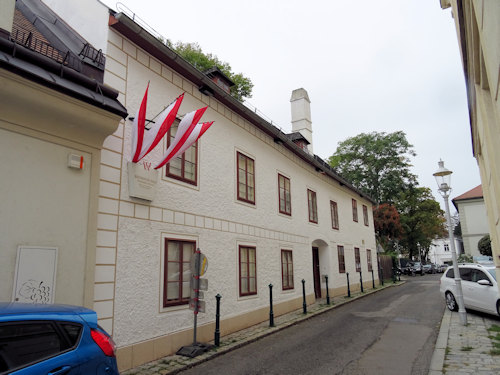
(The Beethoven Museum)
- The Beethoven Pasqualatihaus: a small museum in a city-centre house he once lived in. More of a homage than a museum
- The Haydnhaus: Haydn’s final residence with exhibitions on his work and the times he lived in (with a small Brahms room, too)
- Schubert’s Geburtshaus: a small museum in the house where Schubert was born and spent his early childhood
- Schubert’s Sterbewohung: at the other end of the circle of life, this is the apartment where Schubert died
- The Strausswohnung: a small museum with biographical items and displays. Strauss wrote The Blue Danube here
Discover far more historical locations associated with the lives of Vienna’s iconic musicians and composers here.
Museums of science etc.
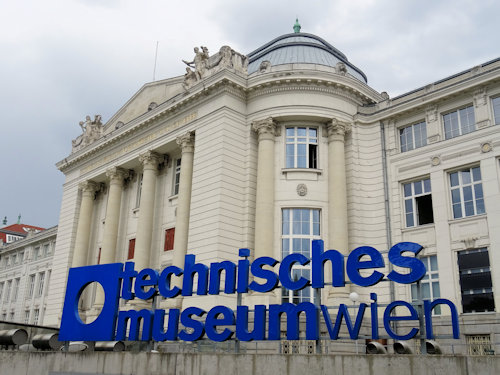
It’s not all about art, history, culture and music, of course. Vienna has numerous other museums. For example:
- The Natural History Museum (Naturhistorisches Museum): filled with geological, anthropological and zoological displays. And dinosaurs! Home to the over 29,000 years-old Venus of Willendorf statue
- The Technical Museum: full of interactive displays and thousands of exhibits tracing technological development through the years. Everything from antique irons to wheelchair simulators
- The Globe Museum: a unique collection of terrestrial, celestial, moon and planet globes, some approaching 500 years old. “Here be dragons” (or Australia)
- The Remise: the city’s public transport museum, full of old-timer trams and other vehicles, as well as interactive information displays
Museums for entertainment
- The Museum of Illusions: a place of amusement and bemusement, not to mention heaven for Instagram pics
- Madame Tussauds: the famous wax museum has a location in Vienna with national and international personalities within. Grab a selfie with Beethoven or Beyoncé
- Retro Gaming Museum: a journey across the evolution of gaming technology with old equipment, consoles and arcade games to try out, too. From Pong to PlayStation.
Watch this space as I get round to visiting more locations.